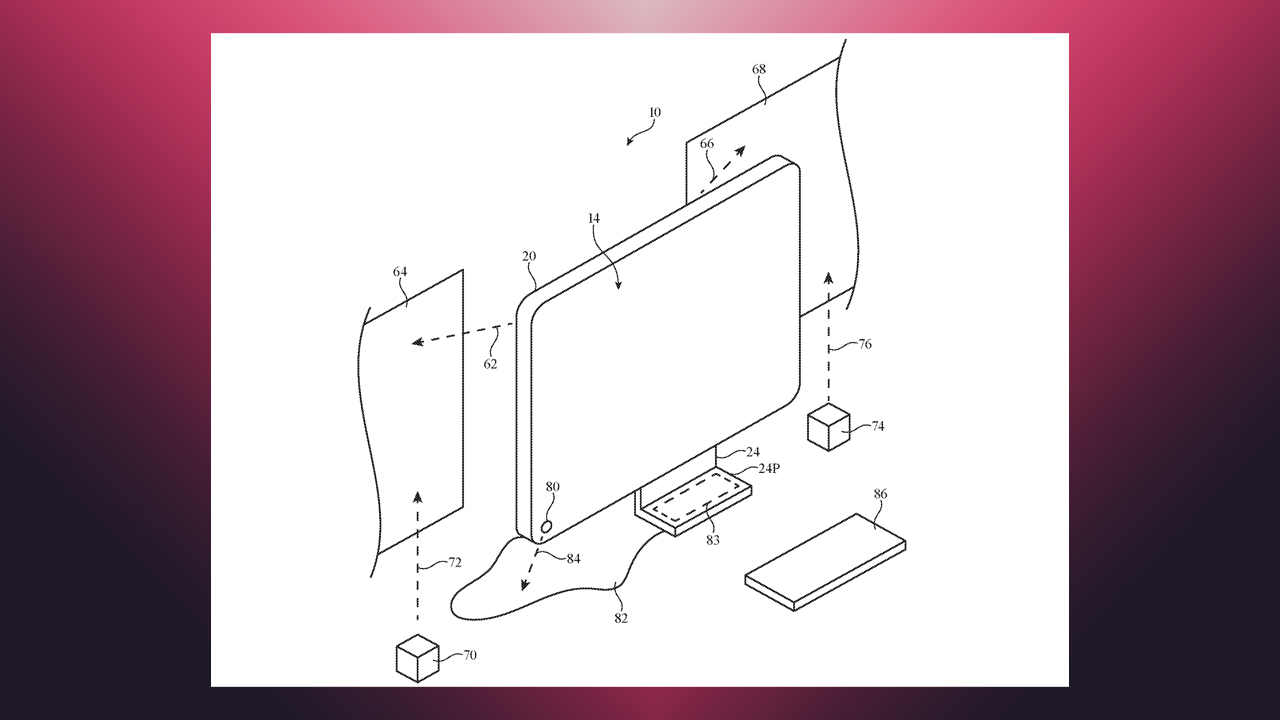A future iMac could steal this wild Philips Ambilight TV idea — but is it really useful?
This iMac patent is one of the crazier ideas we’ve seen Apple file in recent times.

We’ve been long awaiting the arrival of a new iMac, with the latest (read: outdated) release in the all-in-one desktop computing line-up being the colorful 2021 M1 iMac editions. A newly-uncovered patent shows Apple is very much still experimenting with new ideas for future generations of iMac — though it might want to refocus elsewhere if this rather strange idea is anything to go by.
Patent number US 11,630,485 B2 was awarded to Apple this year by the United States Patent Office, and describes a new iMac design that would include rear-facing projection units.
Combining an industrial design that would see the iMac’s main screen component made of a single wraparound piece of glass, the patent describes how projection equipment built into the back of the iMac could be used to extend the computer’s screen to the walls and surfaces behind it.

“In some arrangements, the electronic device may be provided with projecting displays that help enhance the area used for providing a user with visual output,” it reads.
“The rear housing wall may have a glass portion or another transparent structure through which image sensors and other optical sensors receive light.”
It’s an idea reminiscent of Philips’ Ambilight television range, which includes lights built into the back of the screens to ‘extend’ the scene of the image from a film or TV show onto the walls behind it. More specifically, it apes an idea seen in Philips' AmbiLux 4K TV which I remember first seeing way back in September 2015 at the IFA press conference, which used a pico projector array to add more specific detail to the image extension. But any projection used by an iMac for actual productivity purposes would have to be several magnitudes more defined than that, were it to replace any secondary 4K monitors you may currently be using.
What’s really next for iMac?
This of course is all very much future-gazing stuff, and unlikely to be in the realms of possibility for the line up of iMac devices any time soon. While we all want more screen real estate when working on our Macs, it’s hard to envision the implementation from this patent as being one that would be very practical in use. Can you imagine trying to use it in a well-lit office, for instance? Patents are used just as much to protect ideas from competitors as often as they are seen as precursors to actual products.
iMore offers spot-on advice and guidance from our team of experts, with decades of Apple device experience to lean on. Learn more with iMore!
That’s not to say that Apple isn’t considering other methods of expanding the usable screen space of a Mac without adding more physical displays to the equation. One of the key rumored use cases for the upcoming Apple VR Reality Pro headset is being able to create virtual screens for your Mac to work on, for instance. We’ll have to see if that proves true come WWDC 2023 — the headset's expected debut stage.
As for the iMac itself, more likely to come next is a new and improved iMac Pro. Long-rumored, it’s thought to appear alongside any announcement of M3 chipsets, and could sport a larger screen than the existing iMac line-up, as well as a Mini LED ProMotion display similar to the top-end 16-inch MacBook Pro series that headlines the best Mac list this year.

Gerald Lynch is the Editor-in-Chief of iMore, keeping careful watch over the site's editorial output and commercial campaigns, ensuring iMore delivers the in-depth, accurate and timely Apple content its readership deservedly expects. You'll never see him without his iPad Pro, and he loves gaming sessions with his buddies via Apple Arcade on his iPhone 15 Pro, but don't expect him to play with you at home unless your Apple TV is hooked up to a 4K HDR screen and a 7.1 surround system.
Living in London in the UK, Gerald was previously Editor of Gizmodo UK, and Executive Editor of TechRadar, and has covered international trade shows including Apple's WWDC, MWC, CES and IFA. If it has an acronym and an app, he's probably been there, on the front lines reporting on the latest tech innovations. Gerald is also a contributing tech pundit for BBC Radio and has written for various other publications, including T3 magazine, GamesRadar, Space.com, Real Homes, MacFormat, music bible DIY, Tech Digest, TopTenReviews, Mirror.co.uk, Brandish, Kotaku, Shiny Shiny and Lifehacker. Gerald is also the author of 'Get Technology: Upgrade Your Future', published by Aurum Press, and also holds a Guinness world record on Tetris. For real.
